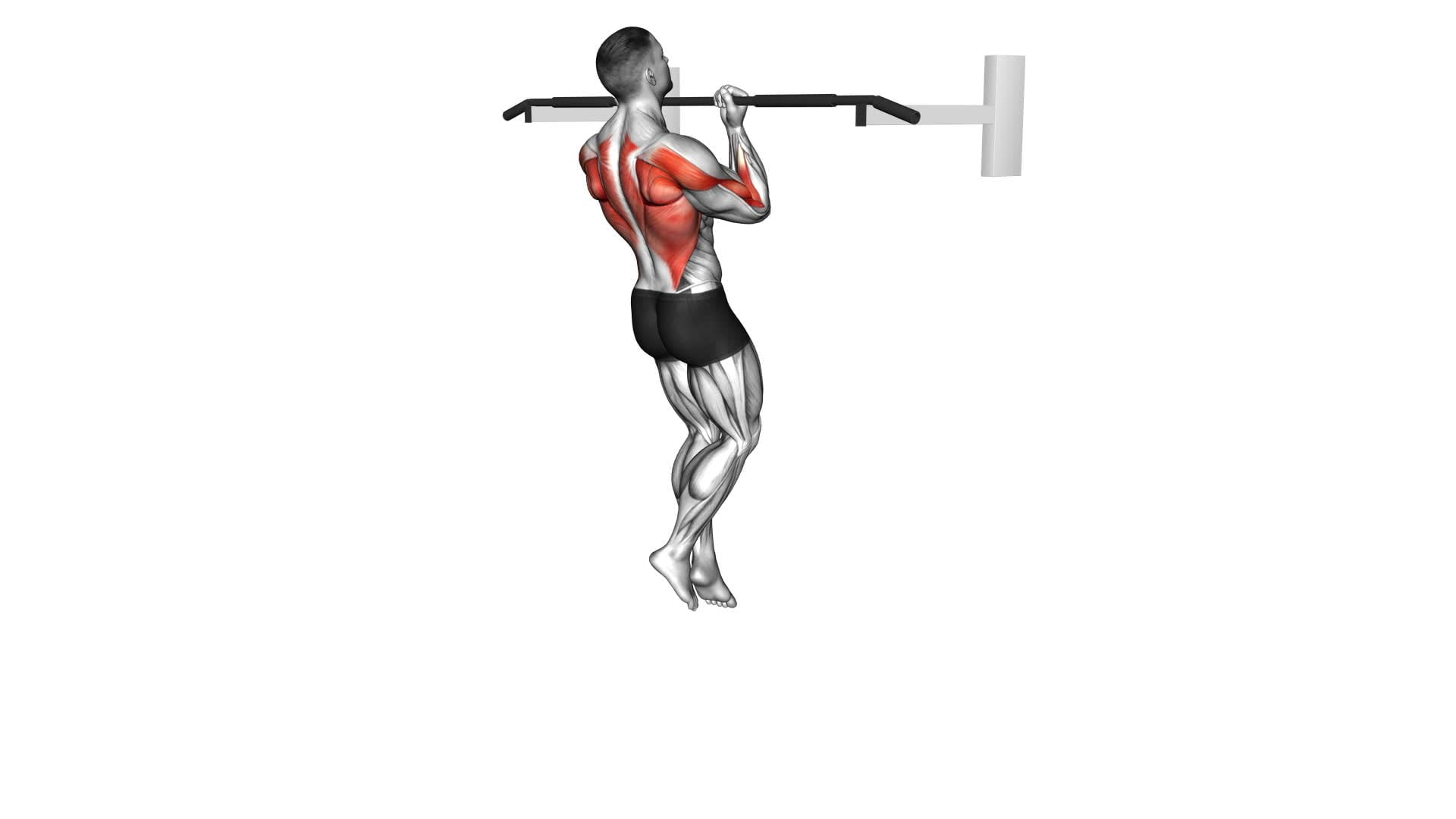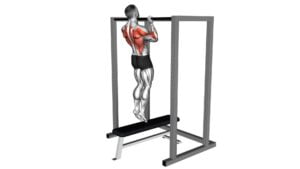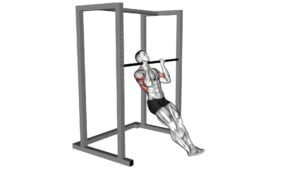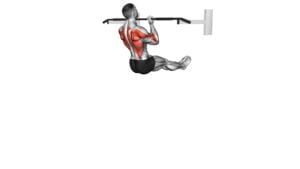Chin-Up – Video Exercise Guide & Tips

Looking to improve your upper body strength and tone your muscles? Look no further than chin-ups!
Watch This Exercise Video
This video exercise guide and tips will show you how to perform chin-ups with proper form and technique.
You'll also discover variations and progressions to challenge yourself, as well as common mistakes to avoid.
Plus, we'll share tips on increasing your chin-up reps and incorporating them into your workout routine.
Get ready to take your fitness to new heights with chin-ups!
Key Takeaways
- Chin-ups can improve upper body strength and increase muscle definition.
- Engaging multiple muscle groups during chin-ups can help improve posture and enhance grip strength.
- Proper form and technique are essential for performing chin-ups correctly and avoiding common mistakes.
- Increasing chin-up reps can be achieved by trying different grip variations and utilizing assisted chin-up techniques.
Benefits of Chin-Ups
Improve your upper body strength and increase muscle definition by incorporating chin-ups into your workout routine. Chin-ups are a highly effective exercise for increasing strength in your upper body, particularly your back, shoulders, and arms. By engaging multiple muscle groups, including the latissimus dorsi, biceps, and deltoids, chin-ups provide a comprehensive upper body workout.
One of the key benefits of chin-ups is their ability to improve posture. As you pull yourself up towards the bar, you activate the muscles in your upper back, which play a crucial role in maintaining good posture. Regularly performing chin-ups can help strengthen these muscles, reducing the risk of rounded shoulders and promoting a more upright posture.
In addition to increasing strength and improving posture, chin-ups also offer a range of other benefits. They can enhance grip strength, as you need to hold onto the bar firmly throughout the exercise. Chin-ups also engage your core muscles, providing a secondary workout for your abdominal muscles.
To maximize the benefits of chin-ups, it's important to maintain proper form. Start by gripping the bar with your palms facing towards you and your hands shoulder-width apart. Keep your body straight as you pull yourself up, aiming to bring your chin over the bar. Lower yourself back down in a controlled manner to complete one repetition.
Incorporating chin-ups into your workout routine can be a challenging yet rewarding way to increase your upper body strength and improve your posture.
Proper Form and Technique
To ensure optimal results and prevent injury, mastering the proper form and technique is essential when performing chin-ups. Common errors in form can lead to ineffective workouts or even strain on your muscles.
One common mistake is swinging your body or using momentum to lift yourself up. This not only takes away from the effectiveness of the exercise but also puts unnecessary stress on your shoulders and back.
Another mistake isn't fully extending your arms at the bottom of the movement. This limits the range of motion and reduces the benefits of the exercise.
To maintain proper form, start by gripping the bar with your palms facing towards you and your hands shoulder-width apart. Keep your core engaged and your shoulders pulled back.
As you pull yourself up, focus on using your back and arms to lift your body, rather than relying on momentum. Aim to bring your chin above the bar and then lower yourself back down with control.
Training tips for mastering proper chin-up technique include starting with assisted chin-ups using a resistance band or machine, gradually increasing your strength and stability. Additionally, focusing on your breathing and maintaining a steady pace can help you maintain proper form throughout the exercise.
Variations and Progressions
Explore different ways to challenge yourself and progress with chin-ups by trying out advanced variations and progressions. Once you have mastered the basic chin-up, you can take your workout to the next level by incorporating these advanced techniques.
One advanced variation is the weighted chin-up. This involves attaching a weight plate or wearing a weighted vest while performing the exercise. Adding extra resistance will increase the difficulty and help you build strength and muscle.
Another advanced variation is the one-arm chin-up. This requires a high level of upper body strength and stability. Start by using a towel or strap for assistance, gradually reducing the assistance until you can perform the chin-up with just one arm.
To further challenge yourself, you can try the muscle-up progression. This involves transitioning from a chin-up to a dip, combining two challenging exercises into one fluid movement. It requires a strong grip, upper body strength, and coordination.
Remember to always prioritize proper form and technique when attempting these advanced variations and progressions. Gradually increase the difficulty as your strength and skill level improve.
Incorporating these advanced techniques into your chin-up routine will help you continue to challenge your muscles and reach new fitness goals.
Common Mistakes to Avoid
As you progress with variations and progressions in chin-ups, it's important to be aware of common mistakes to avoid. Making these mistakes can't only hinder your progress but also increase the risk of injury.
One common mistake is using momentum to swing your body to complete the movement. This not only takes away from the effectiveness of the exercise but can also strain your muscles and joints. To avoid this, focus on maintaining control throughout the entire range of motion.
Another mistake to avoid isn't engaging your core muscles. Your core plays a crucial role in stabilizing your body during chin-ups. By neglecting to engage your core, you put unnecessary stress on your shoulders and lower back.
Additionally, avoid the mistake of pulling yourself up using your biceps only. This can lead to muscle imbalances and increase the risk of injury. Instead, make sure to engage your back muscles and distribute the effort evenly.
Tips for Increasing Chin-Up Reps
Looking to increase your chin-up reps? One tip is to try different grip variations for progress. By switching up your hand positioning, you can target different muscles and challenge your body in new ways.
Additionally, utilizing assisted chin-up techniques, such as using resistance bands or a spotter, can help you build strength and gradually increase your reps over time.
Grip Variations for Progress
To increase your chin-up reps, try incorporating grip variations into your routine.
One effective grip variation is using a pronated grip, where your palms are facing away from you. This grip targets your back muscles and can help increase your overall strength.
Another grip variation is the supinated grip, where your palms are facing towards you. This grip targets your biceps and can help improve your pulling strength.
Additionally, you can try using a neutral grip, where your palms are facing each other. This grip variation targets your shoulder muscles and can provide a different challenge to your chin-ups.
Assisted Chin-Up Techniques
If you're struggling to increase your chin-up reps, incorporating assisted chin-up techniques can be a game-changer. Here are some effective methods to help you progress:
- Negative Chin Ups: Start at the top of the chin-up position and slowly lower yourself down, taking around 3-5 seconds. This eccentric movement builds strength and control, eventually leading to full chin-ups.
- Assisted Chin-Up Machines: These machines have a platform or weight stack that counterbalances your bodyweight, making it easier to perform chin-ups. Gradually decrease the assistance over time to build strength.
- Band Assisted Chin-Ups: Loop a resistance band around the chin-up bar and place your foot or knee in the band while gripping the bar. This provides assistance throughout the movement, allowing you to do more reps.
By incorporating these assisted chin-up techniques into your routine, you can gradually increase your strength and eventually perform unassisted chin-ups.
Now, let's explore how you can incorporate chin-ups into your workout routine.
Incorporating Chin-Ups Into Your Workout Routine
Start by incorporating chin-ups into your workout routine by utilizing proper form and gradually increasing the intensity.
One way to vary your chin-up routine is by experimenting with different grip positions. This will target different muscles in your upper body and help you avoid muscle imbalances. The most common grip positions include the wide grip, narrow grip, and neutral grip.
The wide grip targets your lats and upper back muscles, while the narrow grip focuses more on your biceps and forearms. The neutral grip, with your palms facing each other, engages your biceps and back muscles equally.
If you're just starting out or find chin-ups challenging, you can use resistance bands to assist you. Attach the band to the bar and place your foot or knee in it to reduce the amount of bodyweight you need to lift. As you become stronger, you can gradually decrease the assistance from the bands until you can do chin-ups unassisted.
Remember to maintain proper form throughout the exercise. Start with your arms fully extended and pull yourself up until your chin is above the bar. Lower yourself back down in a controlled manner.
As you progress, you can increase the intensity by adding weight or performing more repetitions. Including chin-ups in your workout routine will help you develop a strong upper body and improve your overall fitness level.
Frequently Asked Questions
How Long Should I Rest Between Sets of Chin-Ups?
To maximize the benefits of chin-ups, it's important to consider rest periods between sets.
Rest periods allow your muscles to recover and prepare for the next set. The length of your rest period depends on your fitness level and goals. Generally, a rest period of 1-3 minutes is recommended for chin-ups.
This gives your muscles enough time to recover while maintaining intensity. Remember, proper rest periods can enhance your strength gains and prevent muscle fatigue.
Can Chin-Ups Help Improve My Grip Strength?
Chin-ups are an excellent exercise for improving your grip strength. Compared to pull-ups, chin-ups involve a supinated grip that targets your biceps and forearms more.
However, if you're looking for alternative exercises to specifically focus on grip strength, you can try exercises like farmer's walks, deadlifts, or hanging leg raises. These exercises target your grip muscles and can help you build a stronger grip over time.
Is It Okay to Use Assisted Chin-Up Machines or Bands for Assistance?
Using assisted chin-up machines or bands for assistance during your chin-up exercises can have both pros and cons.
The main advantage is that they provide support, making it easier for you to perform the exercise and gradually build strength.
However, relying too heavily on assistance can hinder your progress in developing full strength.
It's also important to consider alternative exercises, such as lat pulldowns or inverted rows, to target similar muscle groups and continue challenging yourself.
Are Chin-Ups Suitable for Beginners or Only for Advanced Athletes?
Chin-ups can be suitable for both beginners and advanced athletes. They offer numerous benefits for overall strength, making them a valuable exercise to incorporate into your routine.
If you're a beginner, there are modifications you can make to make chin-ups more accessible, such as using bands for assistance or starting with a neutral grip.
As you progress, you can gradually increase the difficulty by using less assistance or trying different grip variations.
Can I Do Chin-Ups Every Day or Should I Have Rest Days in Between?
You should be mindful of the frequency of your chin-up training.
It's important to give your muscles time to rest and recover, so it's not recommended to do chin-ups every day.
Incorporating rest days in between your chin-up sessions will allow your muscles to repair and grow stronger.
This will help prevent overuse injuries and promote better overall progress in your training.
Conclusion
In conclusion, chin-ups are a highly effective exercise for strengthening the upper body, particularly the back and biceps. By maintaining proper form and technique, and gradually progressing to more challenging variations, you can continue to improve your strength and endurance.
Avoid common mistakes such as swinging or using momentum, and focus on increasing your reps over time. Incorporating chin-ups into your regular workout routine can provide a well-rounded upper body workout.

Author
Years ago, the spark of my life’s passion ignited in my mind the moment I stepped into the local gym for the first time. The inaugural bead of perspiration, the initial endeavor, the very first surge of endorphins, and a sense of pride that washed over me post-workout marked the beginning of my deep-seated interest in strength sports, fitness, and sports nutrition. This very curiosity blossomed rapidly into a profound fascination, propelling me to earn a Master’s degree in Physical Education from the Academy of Physical Education in Krakow, followed by a Sports Manager diploma from the Jagiellonian University. My journey of growth led me to gain more specialized qualifications, such as being a certified personal trainer with a focus on sports dietetics, a lifeguard, and an instructor for wellness and corrective gymnastics. Theoretical knowledge paired seamlessly with practical experience, reinforcing my belief that the transformation of individuals under my guidance was also a reflection of my personal growth. This belief holds true even today. Each day, I strive to push the boundaries and explore new realms. These realms gently elevate me to greater heights. The unique combination of passion for my field and the continuous quest for growth fuels my drive to break new ground.







